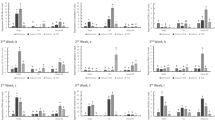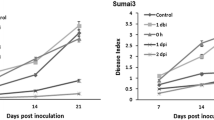Abstract
Late wilt, a severe vascular disease of maize caused by the fungus Harpophora maydis, is characterized by rapid wilting of maize plants before tasseling and until shortly before maturity. The pathogen is currently controlled by resistant maize cultivars, but the disease is constantly spreading to new areas. The plant’s late phenological stage at which the disease appears suggests that plant hormones may be involved in the pathogenesis. This work revealed that plant growth hormones, auxin (Indole-3-acetic acid) and cytokinin (kinetin), suppress H. maydis in culture media and in a detached root assay. Kinetin, and even more auxin, caused significant suppression of fungus spore germination. Gibberellic acid did not alter colony growth rate but had a signal suppressive effect on the pathogens’ spore germination. In comparison, ethylene and jasmonic acid, plant senescing and defense response regulators, had minor effects on colony growth and spore germination rate. Their associate hormone, salicylic acid, had a moderate suppressive effect on spore germination and colony growth rate, and a strong influence when combined with auxin. Despite the anti-fungal auxin success in vitro, field experiments with dimethylamine salt of 2,4-dichlorophenoxyacetic acid (that mimics the influence of auxin) failed to suppress the late wilt. The lines of evidence presented here reveal the suppressive influence of the three growth hormones studied on fungal development and are important to encourage further and more in-depth examinations of this intriguing hormonal complex regulatory and its role in the maize-H. maydis interactions.





Similar content being viewed by others
References
Adie BA, Pérez-Pérez J, Pérez-Pérez MM, Godoy M, Sánchez-Serrano J-J, Schmelz EA et al (2007) ABA is an essential signal for plant resistance to pathogens affecting JA biosynthesis and the activation of defenses in Arabidopsis. Plant Cell Online 19:1665–1681
Bari R, Jones JD (2009) Role of plant hormones in plant defence responses. Plant Mol Biol 69:473–488
Beckers GJM, Spoel SH (2006) Fine-Tuning Plant Defence Signalling: Salicylate versus Jasmonate. Plant Biol 8:1–10
Beyer EM (1973) Abscission support for a role of ethylene modification of auxin transport. Plant Physiol 52:1–5
Brodersen P, Petersen M, Bjørn Nielsen H, Zhu S, Newman MA, Shokat KM et al (2006) Arabidopsis MAP kinase 4 regulates salicylic acid‐and jasmonic acid/ethylene‐dependent responses via EDS1 and PAD4. Plant J 47:532–546
Daub ME (1986) Tissue Culture and the Selection of Resistance to Pathogens. Annu Rev Phytopathol 24:159–186
De Vleesschauwer D, Yang Y, Cruz CV, Höfte M (2010) Abscisic acid-induced resistance against the brown spot pathogen Cochliobolus miyabeanus in rice involves MAP kinase-mediated repression of ethylene signaling. Plant Physiol 152:2036–2052
Degani O (2014) Pathogenicity assay for Cochliobolus heterostrophus G-protein and MAPK signaling deficiency strains. Am J Plant Sci 5:1318–1328
Degani O, Cernica G (2014) Diagnosis and Control of Harpophora maydis, the Cause of Late Wilt in Maize. Adv Microbiol 4:94–105
Degani O, Goldblat Y (2014) Ambient Stresses Regulate the Development of the Maize Late Wilt Causing Agent, Harpophora maydis. Agric Sci 5:571–582
Degani O, Maor R, Hadar R, Sharon A, Horwitz BA (2004) Host physiology and pathogenic variation of Cochliobolus heterostrophus strains with mutations in the G protein alpha subunit, CGA1. Appl Environ Microbiol 70:5005–5009
Degani O, Weinberg T, Graph S (2014) Chemical control of maize late wilt in the field. Phytoparasitica 42:559–570
Drori R, Sharon A, Goldberg D, Rabinovitz O, Levy M, Degani O (2012) Molecular diagnosis for Harpophora maydis, the cause of maize late wilt in Israel. Phytopathol Mediterr 52:16–29
Eckert SE, Hoffmann B, Wanke C, Braus GH (1999) Sexual development of Aspergillus nidulans in tryptophan auxotrophic strains. Arch Microbiol 172:157–166
El-Assiuty EM, Ismael AM, Zeller KA, Leslie JF (1999) Relative colonization ability of greenhouse-grown maize by four lineages of Cephalosporium maydis from Egypt. Phytopathology 89:S23
El-Shafey HA, Claflin LE (eds) (1999) Late Wilt. APS Press, St. Paul, Mn
Friml J, Palme K (2002) Polar auxin transport — old questions and new concepts? In: Hagen G (ed) Perrot-Rechenmann C. Auxin Molecular Biology, Springer Netherlands, pp 273–284
Fromont-Racine M, Senger B, Saveanu C, Fasiolo F (2003) Ribosome assembly in eukaryotes. Gene 313:17–42
Gams W (1971) Cephalosporium-artige Schimmelpilze (Hyphomycetes). G. Fischer, Stuttgart
Grant M, Lamb C (2006) Systemic immunity. Curr Opin Plant Biol 9:414–420
Jameson PE (2000) Cytokinins and auxins in plant-pathogen interactions – An overview. Plant Growth Regul 32:369–380
Johal L, Huber DM, Martyn R (2004) Late wilt of corn (maize) pathway analysis: intentional introduction of Cephalosporium maydis. Pathways Analysis for the Introduction to the U.S. of Plant Pathogens of Economic Importance, In
Kamisaka S, Yanagishima N, Masuda Y (1967) Effect of Auxin and Gibberellin on Sporulation in Yeast. Physiol Plant 20:90–97
Li J, Brader G, Kariola T, Tapio Palva E (2006) WRKY70 modulates the selection of signaling pathways in plant defense. Plant J 46:477–491
Lin Z, Zhong S, Grierson D (2009) Recent advances in ethylene research. J Exp Bot 60:3311–3336
Llorente F, Muskett P, Sanchez-Vallet A, Lopez G, Ramos B, Sanchez-Rodriguez C et al (2008) Repression of the auxin response pathway increases Arabidopsis susceptibility to necrotrophic fungi. Mol Plant 1:496–509
Lorenzo O, Chico JM, Sánchez-Serrano JJ, Solano R (2004) JASMONATE-INSENSITIVE1 encodes a MYC transcription factor essential to discriminate between different jasmonate-regulated defense responses in Arabidopsis. Plant Cell Online 16:1938–1950
MacMillan J (2001) Occurrence of gibberellins in vascular plants, fungi, and bacteria. J Plant Growth Regul 20:387–442
Michail SH, Abou-Elseoud MS, Nour Eldin MS (1999) Seed health testing of corn for Cephalosporium maydis. Acta Phytopathol Entomol Hung 34:35–42
Molinero-Ruiz ML, Melero-Vara JM, Mateos A (2011) Cephalosporium maydis, the cause of late wilt in maize, a pathogen new to Portugal and Spain. Plant Dis 94:379–379
Mur LA, Kenton P, Atzorn R, Miersch O, Wasternack C (2006) The outcomes of concentration-specific interactions between salicylate and jasmonate signaling include synergy, antagonism, and oxidative stress leading to cell death. Plant Physiol 140:249–262
Nakamura T, Tomita K, Kawanabe Y, Murayama T (1982) Effect of auxin and gibberellin on conidial germination in Neurospora crassa II. “Conidial density effect” and auxin. Plant Cell Physiol 23:1363–1369
Navarro L, Bari R, Achard P, Lison P, Nemri A, Harberd NP et al (2008) DELLAs control plant immune responses by modulating the balance of jasmonic acid and salicylic acid signaling. Curr Biol : CB 18:650–655
Payak MM, Lal S, Lilaramani J, Renfro BL (1970) Cephalosporium maydis - A new threat to maize in India. Indian Phytopathol 23:562–569
Pecsi S, Nemeth L (1998) Appearance of Cephalosporium maydis Samra Sabet and Hingorani in Hungary Mededelingen Faculteit Landbouwkundige en Toegepaste Biologische Wetenschappen. Univ Gent 63:873–877
Pieterse CMJ, Leon-Reyes A, Van der Ent S, Van Wees SCM (2009) Networking by small-molecule hormones in plant immunity. Nat Chem Biol 5:308–316
Prusty R, Grisafi P, Fink GR (2004) The plant hormone indoleacetic acid induces invasive growth in Saccharomyces cerevisiae. Proc Natl Acad Sci 101:4153–4157
Robert-Seilaniantz A, Grant M, Jones JD (2011) Hormone crosstalk in plant disease and defense: more than just jasmonate-salicylate antagonism. Annu Rev Phytopathol 49:317–343
Sabet KA, Samra AS, Hingorani MK, Mansour IM (1961) Stalk and root rots of maize in the United Arab Republic. FAO Plant Prot Bull 9:121–125
Sabet KA, Samra AS, Dawood NA (1966) Combined infection with stalk-rot fungi. In: Samra AS, Sabet KA (eds) nvestigations on stalk-rot disease of maize in UAR. Ministry of Agriculture, Government Printing Offices, Cairo, pp 195–204
Sabet KA, Zaher AM, Samra AS, Mansour IM (1970) Pathogenic behaviour of Cephalosporium maydis and C. acremonium. Ann Appl Biol 66:257–263
Sahab AF, Osman AR, Soleman NK, Mikhail MS (1985) Studies on root-rot of lupin in Egypt and its control. Egypt J Phytopathol 17:23–35
Saleh AA, Leslie JF (2004) Cephalosporium maydis is a distinct species in the Gaeumannomyces-Harpophora species complex. Mycologia 96:1294–1305
Saleh AA, Zeller KA, Ismael AS, Fahmy ZM, El-Assiuty EM, Leslie JF (2003) Amplified Fragment Length Polymorphism Diversity in Cephalosporium maydis from Egypt. Phytopathology 93:853–859
Samra AS, Sabet KA, Hingorani MK (1962) A new wilt disease of maize in Egypt. Plant Dis Rep 46:481–483
Samra AS, Sabet KA, Hingorani MK (1963) Late wilt disease of maize caused by Cephalosporium maydis. Phytopathology 53:402–406
Samra AS, Sabet KA, Abdel-Rahim MF (1966) Effect of soil conditions and cultural practices on infection with stalk rots. U.A.R. Ministry of Agric, Government Printing Offices, Cairo, Egypt
Sexton R, Tucker ML, del Campillo E, Lewis LN (1989) The Cell Biology of Bean Leaf Abscission. In: Jackson M (ed) Osborne D. Cell Separation in Plants, Springer Berlin Heidelberg, pp 69–78
Shehata FA (1976) The inheritance of resistence to late wilt caused by Cephalosporium maydis in some corn lines Fac Agric. Al-Azhar, Cairo
Spoel SH, Dong X (2008) Making Sense of Hormone Crosstalk during Plant Immune Responses. Cell Host Microbe 3:348–351
Tsavkelova E, Klimova SY, Cherdyntseva T, Netrusov A (2006) Microbial producers of plant growth stimulators and their practical use: a review. Appl Biochem Microbiol 42:117–126
van Loon LC, Rep M, Pieterse CMJ (2006) Significance of Inducible Defense-related Proteins in Infected Plants. Annu Rev Phytopathol 44:135–162
Walters DR, McRoberts N (2006) Plants and biotrophs: a pivotal role for cytokinins? Trends Plant Sci 11:581–586
Wang D, Pajerowska-Mukhtar K, Culler AH, Dong X (2007) Salicylic acid inhibits pathogen growth in plants through repression of the auxin signaling pathway. Curr Biol : CB 17:1784–1790
Warren HL (1983) Potential disease problems: late wilt of maize. Phytopathology 73:782
Zeller KA, Jurgenson JE, El-Assiuty EM, Leslie JF (2000) Isozyme and amplified fragment length polymorphisms from Cephalosporium maydis in Egypt. Phytoparasitica 28:121–130
Zeller KA, Abou-Serie MI, El-Assuity EM, Fahmy ZM, Bekheet FM, Leslie JF (2002) Relative competitiveness and virulence of four clonal lineages of Cephalosporium maydis from Egypt toward greenhouse-grown maize. Plant Dis 86:373–378
Acknowledgments
We would like to thank Dr. Tsafrir Weinberg (Galilee Seeds, Research and Development (1989) Ltd), Dr. Onn Rabinovitz (Israel Ministry of Agriculture and Rural Development, Consultation Service) and Mr. Shaul Graph (Migal – Galilee Research Institute) for their helpful advice, Tal Magen, Shahar Menashe and Asaf Blatman (Tel-Hai College, Israel) for their technical assistance. This work was supported by a research grant from the Israel Plant Council, Ministry of Agriculture and a research grant from the Jewish National Fund (Keren Kayemeth LeIsrael).
Author information
Authors and Affiliations
Corresponding author
Rights and permissions
About this article
Cite this article
Degani, O., Drori, R. & Goldblat, Y. Plant growth hormones suppress the development of Harpophora maydis, the cause of late wilt in maize. Physiol Mol Biol Plants 21, 137–149 (2015). https://doi.org/10.1007/s12298-014-0265-z
Received:
Revised:
Accepted:
Published:
Issue Date:
DOI: https://doi.org/10.1007/s12298-014-0265-z




